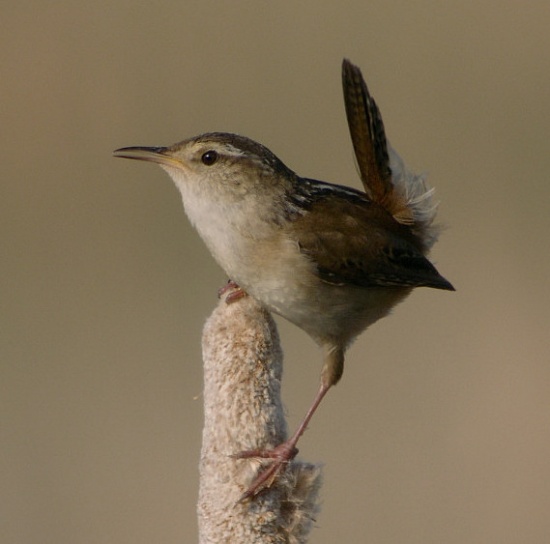- Cistothorus palustris
Identification
A small (13cm., 5in.) stocky wren with a relatively long bill and relatively bright, contrasting markings.
- Brown upperparts
- Light brown belly and flanks
- White throat and breast
- Black back with white stripes
- Dark cap
- White supercilium
- Short thin bill
- Reativey long, pinkish legs adapted for grasping vertical reeds
Distribution
United States and Mexico. See Taxonomy section for detailed distribution of subspecies.
Habitat
This species occurs almost exclusively in marshes with tall vegetation.
Taxonomy
Fifteen subspecies are recognized:[1]
- C. p. browningi - Coastal marshes of sw British Columbia to c Washington
- C. p. paludicola - sw Washington to nw Oregon
- C. p. pulverius - c British Columbia and Idaho to ne California and nw Nevada
- C. p. plesius - se Idaho to Colorado and New Mexico; winters to c Mexico
- C. p. laingi - w-central Canada to Montana; winters to s Mexico
- C. p. iliacus - w-central Canada to w-central USA; winters to Gulf Coast
- C. p. dissaeptus - s-central Canada to n-central USA; winters to ne Mexico
- C. p. clarkae - Coastal c California to n-central USA; winters to ne Mexico
- C. p. aestuarinus - s California (inland valleys), s Nevada, sw Arizona
- C. p. deserticola - s California (deserts)
- C. p. palustris - New England to Virginia
- C. p. waynei - s Virginia to North Carolina
- C. p. griseus - ne South Carolina to e-central Florida
- C. p. marianae (thryophilus) - e Texas to sw Florida
- C. p. tolucensis - c Mexico]
A study shows genetic divisions within this species possibly indicating a future split.
Behaviour
Solitary or in pairs. Tends to remain hidden in tall reed grasses; most often heard rather than seen. Forages within the reeds for food. The males often appear perched on vertical reeds and singing emphatically. Has been known to destroy the eggs of other birds nesting in the grasses, and having its own eggs vandalized in turn.
Breeding
Polygamous. The male builds several globular nests attached to the reeds with side doors; the female chooses one and finishes construction, lining it with feathers and plant material. The nests can be in colonies if the breeding population is dense enough. Incubation of eggs is 12-16 days, by the female. Young stay in nest 11-16 days. Two broods per year.
Diet
Includes insects, spiders and snails, and sometimes other birds' eggs.
Voice
Song
Complex trilling and gurgling songs, with a wide repertoire, especially among the western subspecies. Also sings at night.
Call
An abrasive tuk, similar to the flight calls of some blackbirds, or te-suk-te-suk. Other rattling or chirring calls are possible from within the wide vocal range of this species.
References
- Clements, JF. 2008. The Clements Checklist of Birds of the World. 6th ed., with updates to December 2008. Ithaca: Cornell Univ. Press. ISBN 978-0801445019.
- Paper describing genetic findings with this species




